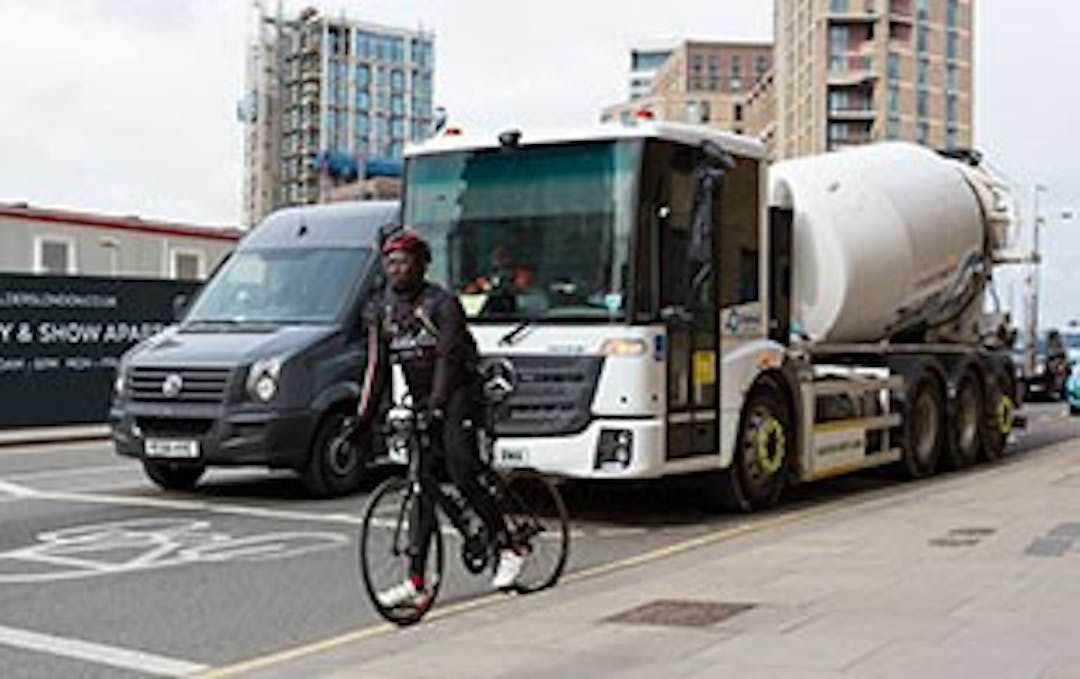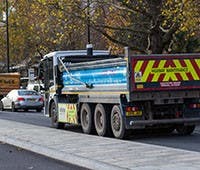Making London's lorries safer - proposals for changes to the HGV Safety Permit Scheme
Consultation has concluded

Update 12 June 2023
After considering all of the responses received and the issues raised, we made a number of modifications to our proposals. We asked London Council’s Transport and Environment Committee (who are the decision making authority for the HGV Safety Permit Scheme) to approve our recommendations at their 8 June 2023 meeting. A copy of the paper they considered is available here.
The Committee approved our recommendations.
Our full report on the consultation, including our response to issues raised in the consultation is now available. We will publish an updated guide on the HGV Safety Permit Scheme along with detailed technical specifications for the Progressive Safe System in July.
- update ends -
Update Spring 2023
The consultation period has now closed. We have reviewed all the feedback received and have used this to inform the recommendations we make to London Councils Transport & Advisory Committee, who are the decision makers for the HGV Safety Permit Scheme. We will take our proposals to their 8 June meeting. We will provide an update to all those that took part in the consultation following the meeting on decision they make. This will include publishing our report on the findings from the consultation and our response to the issues the consultation raised.
- update ends -
We are reviewing how we can further reduce the risk heavy goods vehicles (HGVs) over 12 tonnes pose to vulnerable road users such as people walking and cycling.
Overview
Why are we proposing the Progressive Safe System?
What are we consulting on?
What are the likely impacts?
How can you find out more?
Tell us your views
What happens next?
Overview
The Mayor has adopted Vision Zero for road danger in London with the aim of eliminating all deaths and serious injuries from London’s streets by 2041. In 2019, he launched the world leading Direct Vision Standard (DVS) to improve HGV safety and make London’s streets safer. It became enforceable in March 2021. DVS tackles road danger at its source by minimising HGV blind spots which contribute to many tragic deaths and life-changing injuries.
Fatal collisions involving HGVs and vulnerable road users where vision was a contributory factor have halved since 2018, down from 12 to six. But we must not be complacent. In order to reach the Mayor’s Vision Zero target, we need to go further.
Under the scheme, operators of HGVs must have a permit for any vehicles entering and operating in Greater London. A permit will automatically be granted upon application if the vehicle meets the minimum DVS star rating. Where vehicles do not meet the minimum standard, operators need to make them safer by fitting a ‘Safe System’. This is a series of vehicle safety measures which are designed to reduce the risks that HGVs present to vulnerable road users.
We are proposing to create a Progressive Safe System (PSS), which will build on the requirements of the 2019 Safe System, and ensure that operators in London are using the latest safety technology and equipment. We would welcome your views on our proposals for the PSS.
On this page you can find out about our proposals and their potential impacts, as well as how you can give us your feedback.
You have until 3 April 2023 to give us your views.
Why are we proposing the Progressive Safe System
Evidence from the first year of enforcement has shown reductions in collisions where vision was a contributing factor, but we must not be complacent. In order to reach Vision Zero we will continually seek to reduce collisions wherever possible. A progressive HGV Safety Standard Permit Scheme is key to this.
DVS was always designed to be a progressive scheme. From the beginning we set out that we would tighten the standard and keep the Safe System under review. From October 2024, the minimum DVS rating for HGVs entering and operating in Greater London moves from one star to three stars. Vehicles that have a two star rating or lower must fit the PSS and provide proof of this to obtain a permit.
We are now taking the opportunity to review the Safe System requirements to ensure they are progressive by including developments in technology and equipment, as well as reflecting on our experience of the current Safe System.
What are we consulting on?
Much of what we are proposing seeks to mandate elements of the Safe System that were previously recommendations. We also want to provide clearer performance specifications and improve detection at the front of vehicles.
Below is a summary of the proposals for the PSS and you can find the full detail about our proposals here.
Improving indirect vision
|  Image 1 |
|  Image 2 Image 2 |
|  Image 3 |
Warning vulnerable road users of intended manoeuvres
- Requiring that audio warnings must be fitted to all vehicles, including those with left hand drive, to ensure all vehicles operating in London have the ability to warn of an intended manoeuvre
Warning signage requirements remain unchanged as there is no safety evidence to support alteration
Minimising physical impact of a hazard
Sideguard requirements remain unchanged as there is no safety evidence to support a change
Improving the scheme application process for operators
Following feedback from the freight industry we are also seeking to improve the application process for HGV permits:
We are currently considering aspects such as:
Offering the ability to check permit status via an online tool
Additional ways of improving and automating the process
We are also exploring the possibility of linking the evidence process for the permit with the Fleet Operator Recognition Scheme (FORS) (including acceptable substitutes to FORS) requirements in the future.
Looking to the future
In order to ensure the DVS and PSS remains progressive we want to engage with the industry now about how we can achieve that aim.
We will seek to review the HGV Safety Permit scheme, including the PSS in 2028 in order to evaluate its effectiveness and ensure we have the safest vehicles on our road network.
What are the likely impacts?
It is estimated that the new PSS will be applied to around 165,000 vehicles which is 90% of the existing fleet operating in London.
We have commissioned an Independent Integrated Impact Assessment (IIA) to consider the likely significant economic, social and environmental impacts and impacts on equalities.
The IIA identified only minor operational impacts for the freight industry. However, it is acknowledged that timescales could be a challenge due to ongoing supply chain and skills challenges, likely to affect mainly operators with larger fleets.
The main benefits of the proposals come from reduced road fatalities and serious injuries, plus increased levels of walking and cycling as a result of people feeling safer on the roads.
How can you find out more?
We have provided more information to help you respond. Visit the Document Library for:
DVS One year on report
The Integrated Impact Assessment (IIA)
More information about our proposals for the PSS
- Loughborough University's Academic Research Report
A copy of our consultation survey in case you would prefer to respond offline
We also have an Easy Read and British Sign Language (BSL) version of our proposals and survey. If you need to translate this page into another language, please use the ‘Select language’ button in the bottom-left hand corner of this page.
What happens next?
Once the consultation has closed, we will consider all the feedback. This will be used to inform the final recommendations we make to London Council’s Transport and Environment Committee, which is the body which manages the HGV Safety Permit scheme. They will decide whether to adopt the recommendations.
We will publish the final PSS requirements in summer 2023 following analysis of consultation responses and confirmation of the requirements by London Councils. The PSS would become a requirement of the HGV Safety Permit Scheme from October 2024 when the DVS phase two is expected to be formally implemented.
Please let us know if you have any questions that will help you respond to the consultation. We will then get back to you. Note this tool is not for responding to the consultation, please do that via the survey.
Please note that any questions you ask may be visible to others and will be subject to moderation. Any personal information will be kept confidential but your user name will be displayed. Further details on moderation are available here.
Questions asked may be publicly available after the consultation has closed and we may also include them in the form of a report on the results of the consultation exercise, but any personal information will be kept confidential. Your personal information will be properly safeguarded and processed in accordance with the requirements of privacy and data protection legislation. For further information, please visit our privacy policy.









